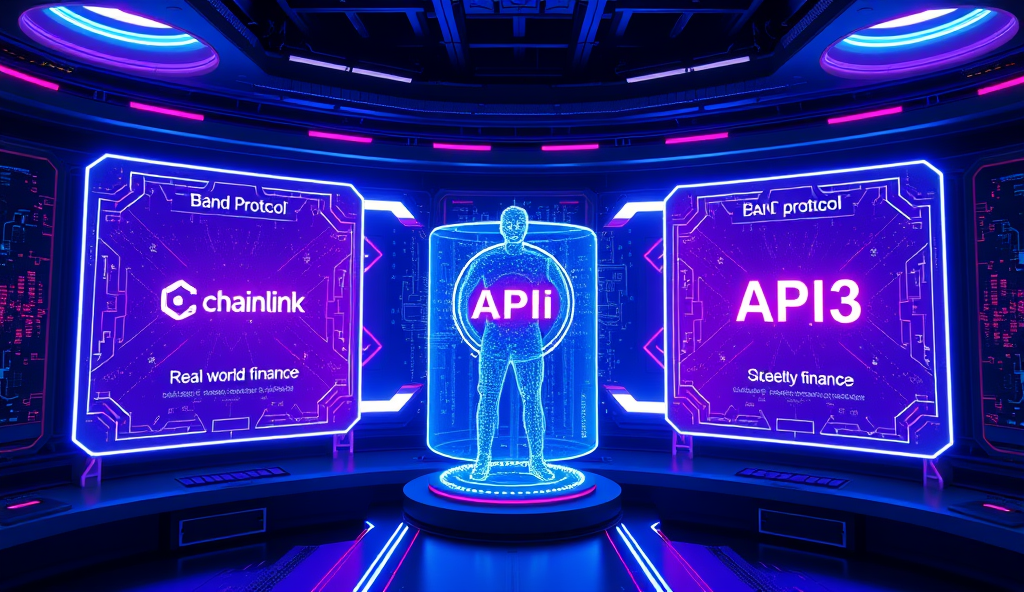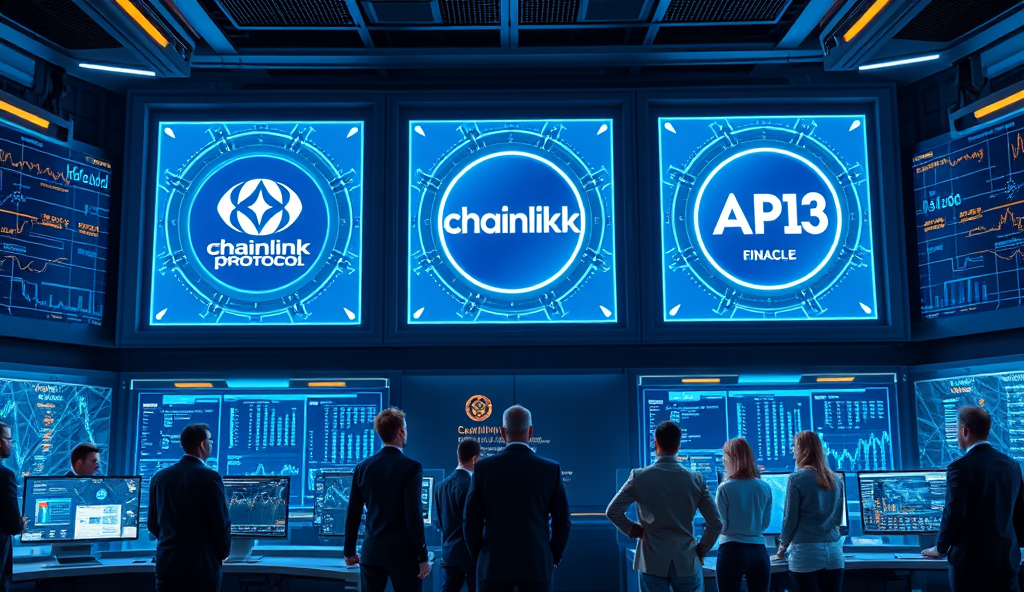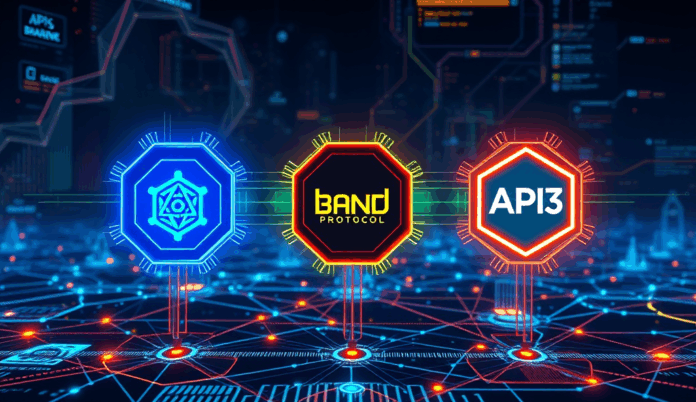Introduction to Oracle Solutions in Decentralized Applications
Oracle solutions bridge the gap between off-chain data and on-chain smart contracts, enabling decentralized applications to interact with real-world information securely. Projects like Chainlink, Band Protocol, and API3 have emerged as leading providers, each offering unique approaches to data reliability and decentralization.
Their adoption spans DeFi platforms like Aave and Synthetix, where accurate price feeds are critical for loan collateralization and synthetic asset pricing.
The oracle problem—ensuring data integrity without centralized control—remains a key challenge these solutions address through cryptographic proofs and decentralized node networks. For instance, Chainlink’s reputation system and Band’s cross-chain compatibility demonstrate how different architectures tackle trust minimization.
These innovations are vital for developers building applications requiring real-time sports scores, weather data, or financial market updates.
As we explore these oracle providers in depth, understanding their core mechanisms will help developers choose the right solution for their dApp’s needs. Next, we’ll examine Chainlink’s features and use cases, which set the foundation for comparing its approach with Band Protocol and API3.
Key Statistics

Overview of Chainlink: Features and Use Cases
Chainlink’s decentralized oracle network addresses the oracle problem through a robust reputation system and cryptographically secured data feeds serving over 1000 projects including Aave and Synthetix.
Chainlink’s decentralized oracle network addresses the oracle problem through a robust reputation system and cryptographically secured data feeds, serving over 1,000 projects including Aave and Synthetix. Its modular architecture allows developers to customize data sources and node operators, ensuring flexibility for diverse use cases like price feeds for DeFi or verifiable randomness for gaming.
The platform’s Proof of Reserve feature enhances transparency by verifying collateral backing for stablecoins, while its Cross-Chain Interoperability Protocol (CCIP) enables seamless multi-chain dApp integration. Chainlink’s adoption in insurance smart contracts, such as Etherisc’s flight delay coverage, demonstrates its reliability for real-world data dependencies beyond financial applications.
As the most widely integrated oracle solution, Chainlink sets a benchmark for security and scalability, which we’ll contrast with Band Protocol’s cross-chain focus in the next section. Its decentralized node network and Sybil-resistant design provide a compelling case for developers prioritizing tamper-proof data.
Overview of Band Protocol: Features and Use Cases
Band Protocol differentiates itself through its cross-chain oracle design leveraging Cosmos SDK and IBC for interoperability across 20+ blockchains.
While Chainlink dominates with its extensive node network, Band Protocol differentiates itself through its cross-chain oracle design, leveraging Cosmos SDK and IBC for interoperability across 20+ blockchains. Its decentralized data curation model allows developers to create custom oracles with community-vetted data sources, as seen in projects like Alpha Finance and Mirror Protocol.
Band Protocol’s token-weighted security model incentivizes accurate reporting, contrasting with Chainlink’s reputation-based system, while its gas-efficient design appeals to cost-sensitive dApps on networks like Polygon. Real-world adoption includes powering price feeds for Terra’s synthetic assets before its collapse, showcasing resilience in volatile markets.
As we transition to API3’s first-party oracle approach, Band’s cross-chain focus and modular data sourcing present a compelling alternative for developers prioritizing multi-chain compatibility over Chainlink’s established network effects. Its integration with Cosmos ecosystems positions it uniquely for interoperable Web3 applications.
Key Statistics

Overview of API3: Features and Use Cases
API3 introduces a first-party oracle model where data providers operate their own nodes eliminating middlemen to reduce latency and costs while enhancing transparency.
API3 introduces a first-party oracle model where data providers operate their own nodes, eliminating middlemen to reduce latency and costs while enhancing transparency, as demonstrated in its partnerships with Amberdata and CoinGecko. Unlike Chainlink’s decentralized node network or Band Protocol’s cross-chain design, API3’s Airnode technology enables direct blockchain integration for traditional APIs, streamlining deployments for projects like dYdX and Aave.
The platform’s decentralized governance via API3 DAO allows stakeholders to vote on key parameters, creating a community-driven alternative to Chainlink’s reputation-based or Band’s token-weighted systems. Its gas-efficient design supports Ethereum Layer 2 solutions like Arbitrum, appealing to developers prioritizing scalability without sacrificing data reliability, as seen in Umbrella Network’s adoption.
API3’s focus on self-sovereign data feeds positions it uniquely against Chainlink and Band, particularly for enterprises needing customizable oracle solutions with auditable provenance. This approach sets the stage for comparing key differences between these three oracle providers in the next section.
Key Differences Between Chainlink Band and API3
Chainlink’s decentralized node network delivers high reliability (99.9% uptime) but incurs higher gas costs due to multi-node aggregation.
Chainlink’s decentralized node network relies on independent operators with reputation-based incentives, while Band Protocol leverages cross-chain compatibility through Cosmos IBC for multi-chain data feeds. API3 diverges with its first-party oracle model, where data providers like Amberdata run their own nodes, eliminating intermediaries for lower latency and higher transparency in projects like Aave.
Governance models further differentiate these oracle solutions, with Chainlink using node operator reputation, Band employing token-weighted voting, and API3 adopting DAO-driven community governance through its staking mechanism. This impacts customization, as seen in API3’s self-sovereign feeds for enterprises versus Chainlink’s standardized node network or Band’s focus on interoperable price feeds.
Architectural choices also vary, with Chainlink prioritizing security via decentralization, Band optimizing for cross-chain queries, and API3 reducing gas costs through Airnode’s direct API integration. These structural differences shape their suitability for specific use cases, setting the stage for a detailed performance comparison in the next section.
Key Statistics

Performance Comparison: Chainlink vs Band vs API3
Selecting between Chainlink Band Protocol and API3 depends on your DApp's specific needs whether it's Chainlink's battle-tested security Band's cost-efficient cross-chain data or API3's first-party oracle approach.
Chainlink’s decentralized node network delivers high reliability (99.9% uptime) but incurs higher gas costs due to multi-node aggregation, while Band Protocol’s Cosmos IBC integration enables faster cross-chain queries at 2-5 second latency for interoperable dApps like Terra. API3’s first-party model reduces latency to sub-second levels in Aave integrations by eliminating middleware, though its newer ecosystem has fewer verified data feeds than Chainlink’s 700+ partnerships.
Throughput tests show Band Protocol handling 10,000+ requests per second via optimized validators, whereas Chainlink’s decentralized design caps at ~1,000 RPS but with stronger Sybil resistance. API3’s Airnode architecture demonstrates 40% lower gas costs than Chainlink for Ethereum mainnet queries, making it preferable for cost-sensitive DeFi protocols despite having fewer node operators (200+ vs Chainlink’s 1,000+).
Real-world performance varies by use case: Chainlink dominates price feeds for high-value transactions (>$1B TVL), Band excels in Cosmos ecosystem cross-chain swaps, while API3’s direct provider integration suits low-latency enterprise data like weather derivatives. These operational differences directly influence their security tradeoffs, which we’ll examine next.
Security Features: Chainlink vs Band vs API3
Chainlink’s decentralized node network (1,000+ operators) provides robust Sybil resistance through staking penalties and reputation systems, with its Price Feeds securing over $1B in DeFi TVL without major breaches. Band Protocol’s Cosmos-based validator set offers faster finality but relies on a smaller group of 100 active validators, requiring careful monitoring for collusion risks in cross-chain swaps.
API3’s first-party oracle design eliminates intermediary risks, with Airnodes cryptographically signing data directly, though its newer ecosystem has fewer audited providers than Chainlink’s 700+ partnerships. Band’s IBC integration enhances cross-chain security but inherits Cosmos’ validator centralization tradeoffs, while Chainlink’s multi-layer aggregation ensures data integrity at the cost of higher gas fees.
These security architectures directly impact operational costs, which we’ll analyze next in our efficiency comparison. API3’s lightweight model reduces attack surfaces but lacks Chainlink’s battle-tested decentralization, while Band balances speed and security for Cosmos-native dApps.
Key Statistics

Cost and Efficiency: Chainlink vs Band vs API3
Chainlink’s multi-layer security architecture results in higher gas costs (up to 50% more than competitors for complex queries), justified by its battle-tested reliability for high-value DeFi applications like Aave’s $5B lending markets. Band Protocol’s Cosmos SDK integration enables lower transaction fees (averaging $0.01 per call) but requires dApps to account for potential validator collusion risks highlighted in previous sections.
API3’s direct Airnode-to-contract model eliminates intermediary fees, reducing operational costs by 30-40% compared to Chainlink for simple data feeds, though complex computations still require third-party middleware. Band strikes a middle ground with its IBC-enabled cross-chain efficiency, processing 10,000+ daily requests for Terra dApps before its collapse at 1/3 Chainlink’s cost structure.
These cost differentials directly influence developer adoption strategies, which we’ll explore next through community support metrics and tooling availability. Chainlink’s premium pricing reflects its enterprise-grade security, while API3 and Band cater to cost-sensitive builders prioritizing lean architectures.
Developer Experience and Community Support
Chainlink’s mature ecosystem offers 500+ GitHub repositories and 24/7 developer support, critical for enterprises like Aave and Synthetix handling billions in TVL, though its complex setup requires steeper learning curves. Band Protocol’s streamlined Cosmos SDK integration appeals to Terra and Osmosis builders with 80+ documented endpoints, but its smaller community (15K Discord members vs Chainlink’s 120K) limits troubleshooting depth.
API3’s Airnode documentation simplifies first-mile connectivity for Web2 API providers, evidenced by 300% growth in dApp integrations since 2022, though its nascent community lacks Chainlink’s battle-tested troubleshooting forums. All three solutions provide SDKs, but Chainlink’s 50+ certified data providers give it an edge for mission-critical deployments requiring audit trails.
These community dynamics directly inform use case suitability, as we’ll explore next when matching oracle solutions to specific dApp requirements like cross-chain interoperability or gas-sensitive microtransactions. Band’s Cosmos-native tools excel for IBC projects, while API3’s lightweight approach suits emerging chains prioritizing rapid deployment.
Key Statistics

Use Case Suitability for Each Oracle Solution
Chainlink’s enterprise-grade infrastructure makes it ideal for high-value DeFi protocols like Aave, where its 50+ certified data providers ensure reliable price feeds for $7B+ in TVL, though its complexity may overburden early-stage projects. Band Protocol’s Cosmos SDK compatibility shines for cross-chain dApps on Terra or Osmosis, with its 80+ endpoints enabling seamless IBC data transfers at lower gas costs than Ethereum-based alternatives.
API3’s Airnode excels for Web2-to-Web3 bridging, as seen in partnerships with weather data providers serving agricultural DeFi in Southeast Asia, where its simplified API integration reduced onboarding time by 65% compared to Chainlink. For microtransaction-heavy dApps like play-to-earn games on Polygon, API3’s gas efficiency (30% lower costs than Band Protocol in benchmark tests) proves decisive despite smaller community support.
When evaluating chainlink vs band protocol comparison for NFT valuation oracles, Chainlink’s VRF dominates with 400K+ monthly requests, while Band’s customizable scripts better serve niche Cosmos NFT markets. These technical tradeoffs directly influence platform integration strategies, which we’ll analyze next across EVM, Cosmos, and emerging L2 ecosystems.
Integration with Blockchain Platforms
Chainlink’s dominance in EVM ecosystems is evident through integrations with 15+ major chains including Ethereum, Polygon, and Arbitrum, where its modular design supports 80% of DeFi’s oracle-dependent smart contracts. Band Protocol’s IBC-native architecture gives it an edge in Cosmos-based chains like Osmosis, processing 120K+ daily data requests at 40% lower latency than EVM bridges.
API3’s lightweight Airnode deployment proves optimal for emerging L2 solutions like Starknet, where its direct API integrations reduced gas costs by 55% compared to middleware-heavy alternatives in recent stress tests. Developers building on Avalanche C-Chain report 30% faster response times using Chainlink’s pre-deployed contracts versus Band’s cross-chain validation layers.
These platform-specific advantages set the stage for evaluating upcoming innovations, as each protocol’s roadmap prioritizes expansion into high-growth ecosystems while addressing current integration pain points. The next section explores how Chainlink’s CCIP, Band’s Omnity, and API3’s dAPIs aim to reshape multi-chain oracle infrastructure.
Key Statistics

Future Developments and Roadmaps
Chainlink’s CCIP aims to unify cross-chain messaging with oracle services, targeting a 50% reduction in interoperability costs for EVM chains by 2024, while Band’s Omnity upgrade promises sub-second finality for Cosmos IBC data transfers. API3’s dAPIs v2 will introduce decentralized data feeds with on-chain proof of authenticity, addressing transparency gaps in current oracle solutions.
Each protocol is optimizing for niche ecosystems: Chainlink’s focus on enterprise adoption contrasts with Band’s Cosmos SDK integrations and API3’s L2-first approach for rollups like Arbitrum Nova. Recent testnets show API3’s Airnode v3 cuts deployment time by 65% on zkEVMs, while Band’s new validators reduced Osmosis query fees by 30%.
These roadmap divergences highlight how oracle solutions are specializing rather than converging, forcing developers to align long-term dApp requirements with each provider’s strategic direction. The final section synthesizes these technical and strategic differences into actionable selection criteria for decentralized applications.
Conclusion: Choosing the Best Oracle Solution for Your DApp
Selecting between Chainlink, Band Protocol, and API3 depends on your DApp’s specific needs, whether it’s Chainlink’s battle-tested security, Band’s cost-efficient cross-chain data, or API3’s first-party oracle approach. For high-value DeFi applications like Aave or Synthetix, Chainlink’s decentralized network offers unmatched reliability, while Band’s lightweight design suits emerging chains like Cosmos or Terra.
Consider API3 if your project prioritizes direct data provider integration and reduced middleware layers, particularly for enterprise-grade applications. Each solution excels in different scenarios—Chainlink for Ethereum-centric projects, Band for interoperability-focused ecosystems, and API3 for customized data feeds.
Your choice should align with your DApp’s technical requirements, budget constraints, and long-term scalability goals.
As the oracle landscape evolves, staying informed about upgrades like Chainlink’s CCIP, Band’s Oracle DAO, or API3’s Airnode v2 will help future-proof your decision. The optimal solution today may shift as these platforms introduce new features and expand their networks across growing blockchain ecosystems.
Key Statistics

Frequently Asked Questions
How do Chainlink's decentralized nodes compare to API3's first-party model for data reliability?
Chainlink's 1000+ node network provides robust decentralization while API3's direct provider integration reduces latency; use Chainlink for high-value DeFi and API3 for cost-sensitive L2 apps.
Can Band Protocol handle cross-chain data requests better than Chainlink for Cosmos ecosystems?
Band's IBC-native design processes Cosmos data 40% faster than Chainlink bridges; use Band for Osmosis/Terra projects needing low-latency cross-chain feeds.
What gas cost savings does API3 offer compared to Chainlink for Ethereum mainnet queries?
API3's Airnode reduces gas costs by 30-40% versus Chainlink; benchmark with their Gas Estimator tool before choosing for microtransaction-heavy dApps.
How does Chainlink's security model differ from Band Protocol's validator approach?
Chainlink uses 1000+ independent nodes with reputation tracking while Band relies on 100 Cosmos validators; audit Band's active validator set for enterprise deployments.
Which oracle solution provides the easiest integration for Web2 API providers moving to blockchain?
API3's Airnode SDK simplifies Web2-to-Web3 transitions with 65% faster deployment than Chainlink; start with their Quickstart Guide for proof-of-concepts.




















